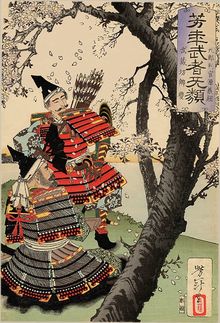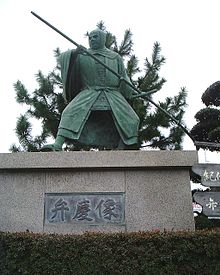- Benkei
-
 Benkei by Kikuchi Yosai
Benkei by Kikuchi Yosai
 Benkei with Yoshitsune
Benkei with Yoshitsune
 Benkei's statue at Kii Tanabe station
Benkei's statue at Kii Tanabe station
Saitō no Musashibō Benkei (西塔の武蔵坊弁慶, 1155–1189), popularly called Benkei, was a Japanese warrior monk (sōhei) who served Minamoto no Yoshitsune. He is commonly depicted as a man of great strength and loyalty, and a popular subject of Japanese folklore.
Contents
Biography
Stories about Benkei's birth vary considerably. One tells how his father was the head of a temple shrine who had raped his mother, the daughter of a blacksmith. Another sees him as the offspring of a temple god. Many give him the attributes of a demon, a monster child with wild hair and long teeth. In his youth Benkei may have been called Oniwaka (鬼若)—"demon/ogre child", and there are many famous Ukiyo-e works themed on 'Oniwakamaru' and his adventures.
He joined the cloister at an early age and travelled widely among the monasteries of Japan. During this period, the Buddhist monasteries of Japan were important centres of administration and culture, but also military powers in their own right. Like many other monks, Benkei was probably trained in the use of the naginata. At the age of seventeen, he was said to have been over two metres (6.6 feet) tall. At this point, he left the Buddhist monastery and became a yamabushi, a member of a sect of mountain monks who were recognisable by their black caps. Japanese prints often show Benkei wearing this cap.
Benkei is said to have posted himself at Gojō Bridge in Kyoto, where he disarmed every passing swordsman, eventually collecting 999 swords. On his 1000th duel, Benkei was defeated by Minamoto no Yoshitsune, a son of the warlord Minamoto no Yoshitomo. Henceforth, he became a retainer of Yoshitsune and fought with him in the Genpei War against the Taira clan.[1] Yoshitsune is credited with most of the Minamoto clan's successes against the Taira, especially the final naval battle of Dannoura. After their ultimate triumph, however, Yoshitsune's elder brother Minamoto no Yoritomo turned against him.
During the two year ordeal that followed, Benkei accompanied Yoshitsune as an outlaw. In the end, they were encircled in the castle of Koromogawa no tate. As Yoshitsune retired to the inner keep of the castle to commit ritual suicide (seppuku) on his own, Benkei fought on at the bridge in front of the main gate to protect Yoshitsune. It is said that the soldiers were afraid to traverse the bridge to confront him, and all that did met swift death at the hands of the gigantic man. Long after the battle should have been over, the soldiers noticed that the arrow-riddled, wound-covered Benkei was standing still. When the soldiers dared to cross the bridge and look more closely, the giant fell to the ground, having died in a standing position. This is known as the "Standing Death of Benkei" (弁慶の立往生, Benkei no Tachi Ōjō).
It is Benkei's loyalty and honour which makes him most attractive in Japanese folklore. One kabuki play places Benkei in a moral dilemma, caught between lying and protecting his lord in order to cross a bridge. The critical moment of the drama is its climax, where the monk realises his situation and vows to do what he must. In another play, Benkei even slays his own child to save the daughter of a lord. In the Noh play Ataka, Benkei must beat his own master (disguised as a porter) in order to avoid breaking his disguise. Ataka is later adapted as the kabuki play Kanjinchō, and filmed by Akira Kurosawa as The Men Who Tread on the Tiger's Tail.
In popular culture
- The Tale of Benkei was serialized in the first three issues of the short-lived British comic book series Tornado in 1979.
- The third pilot of the original Getter team was Tomoe Musashi, and his successor after his death was Kuruma Benkei. The two characters are combined for a more direct tribute in the character of Musashibou Benkei in the OAV New Getter Robo, who is also a monk.
- In the video game Okami, Benkei is first seen on a bridge fishing for his 1000th sword. In this case, it was a legendary fish known as the "Living Sword" (a fish which has a sword-like appearance, named the Cutlass Fish). He prevents the protagonist (a wolf avatar of the Shinto sun god, Okami Amaterasu) from crossing the bridge until he catches it.
- He is a playable character in the video game, Genji: Dawn of the Samurai, and the sequel Genji: Days of the Blade, where he is portrayed as a large club-wielding warrior monk, and a faithful companion to the main character, Yoshitsune.
- He also appears in the collectible card game, Yu-Gi-Oh!, as a DARK-type Warrior monster by the name of "Armed Samurai - Ben Kei". The original Japanese version of the card depicted a warrior monk pierced with many arrows, referencing Benkei's famous death. The arrows were removed for the international release, ostensibly for being too graphic.
- A highly fictionalized version of Benkei is the central character of the Shike saga of novels written by Robert Shea. In the novels, his name is Jebu, a warrior monk from the order of Zinja. The books detail his life from age 17 to his meeting with Yoshitsune, right through to the Mongol Invasions of Japan.
- Benkei is also the name of the main character in the noir manga Benkei in New York by Jinpachi Mori and Jiro Taniguchi.
Notes
- ^ Kitagawa, Hiroshi et al. (1975). The Tale of the Heike, pp. 535, 540, 654, 656, 669.
References
- Ribner, Susan, Richard Chin and Melanie Gaines Arwin. (1978). The Martial Arts. New York: Harper & Row. 10-ISBN 0-06-024999-4; 13-ISBN 978-0-06-024999-1.
- Kitagawa, Hiroshi and Bruce T. Tsuchida. (1975). The Tale of the Heike. Tokyo: University of Tokyo Press. ISBN 0-86008-189-3.
- Yoshikawa, Eiji. (1956). The Heike Story: A Modern Translation of the Classic Tale of Love and War. New York: Alfred A. Knopf. ASIN B0007BR0W8 (cloth).
- _____. (1981). The Heike Story: A Modern Translation of the Classic Tale of Love and War. Tokyo: Tuttle Publishing. 10-ISBN 0-8048-1376-0; 13-ISBN 978-0048-1376-1 (paper).
- _____. (2002). The Heike Story: A Modern Translation of the Classic Tale of Love and War. Tokyo: Tuttle Publishing. 10-ISBN 0-8048-3318-4; 13-ISBN 978-0-8048-3318-9 (paper).
- (Japanese) _____. (1989) Yoshikawa Eiji Rekishi Jidai Bunko (Eiji Yoshikawa's Historical Fiction), Vols. 47–62 Shin Heike monogatari (新平家物語). Tokyo: Kodansha. 10-ISBN 4-06-196577-8; 13-ISBN 978-4-06-196577-5.
External links
- Grunwald Center for the Graphic Arts, UCLA Hammer Museum: woodcut print -- "Ushiwaka and Benki duelling on Gojo Bridge" or "Gojo Bridge, an episode from the Life of Yoshitsune, Chronicles of Yoshitsune" by Tuskioka Yoshitoshi (1839-1892)
Categories:- 1155 births
- 1189 deaths
- Japanese folklore
- Japanese warrior monks
- Japanese warriors killed in battle
- People of Heian period Japan
- People of Kamakura period Japan
Wikimedia Foundation. 2010.
